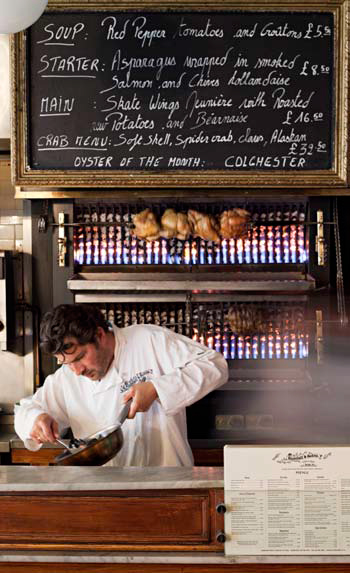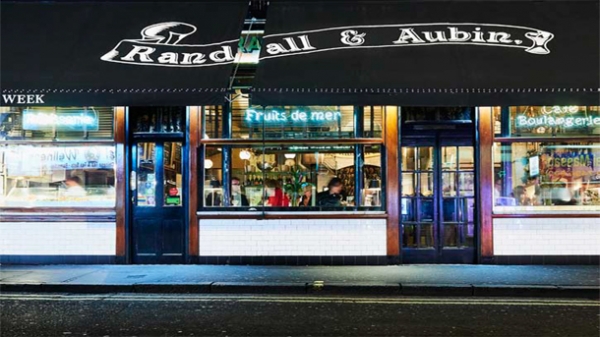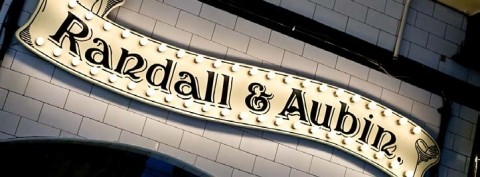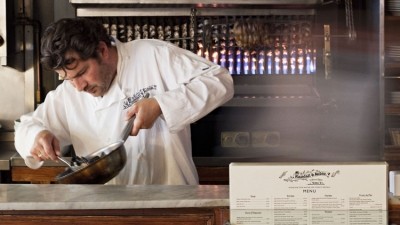Shelling Out: Why Randall & Aubin is making the move to Manchester
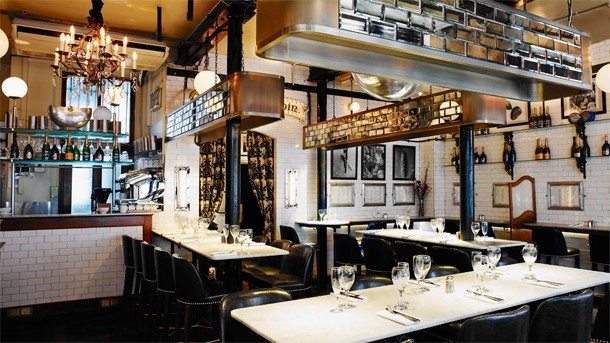
The sex industry was still in full swing, albeit reduced to a smaller red light district around Berwick Street and Brewer Street, and all-day brasseries weren’t the regular feature they are today. Indeed, the restaurant’s early clientele were somewhat colourful.
“When we came here there were local sex shops, hookers and drug dealers,” recalls Poulton. “There were four sex shops and a brothel directly opposite us, which was one of the oldest in London. Let’s just say our first set of customers were definitely local.”
Wind the clock forward 20 years and even though Soho has undergone a transformation, Randall & Aubin has remained a constant, with the restaurant having hardly changed in the two decades it has been open. Moreover, with its open kitchen, white tiles, marble table tops, bar seating and wide-reaching all-day menu, the seafood-focused brasserie looks as if it could have been opened yesterday, such has been its future-proof design.
“We didn’t design it with the future in mind,” shrugs Poulton, who says that the only thing that has really changed about the interior has been “getting rid of the horribly uncomfortable seats” and adding the odd design touch here and there, including installing a disco ball. “Outside on the street has changed a lot more.”
It’s fair to say that while Randall & Aubin looks the part, it certainly wasn’t created as a design-led restaurant. Much of its interior has been dictated by what was on the site before it – a noted French butcher’s dating back to 1908 that counted Winston Churchill as a customer – with Poulton and Baines even keeping the name. The light fittings are the same, as are the shelves. The biggest change is that the basement is no longer used as an abattoir, as it was when it was a butcher’s, where live cattle were brought to be slaughtered, but for the more prosaic practice of storing wine.
“Randall & Aubin looks like a creative brand,” he admits. “Very early on, Whitbread asked us to do a rollout, but this is not a roll-out concept.”
The birth of a French brasserie
This choice of not making too many changes was partly down to circumstance. Before entering into the restaurant business, Poulton ran Greenwich Market and prior to that was a trader in the city – “which gave me absolutely no experience at all,” he says. His enticement into the industry came from restaurateur and neighbour Chris Corbin, with whom he used to play tennis and would accompany to his restaurant Le Caprice. “That was basically my introduction to restaurants,” he says. “It was a bit rose-tinted to think that was how it was.”
Baines, by contrast, had a lot of restaurant experience having undertaken an apprenticeship with Anton Mosimann at The Dorchester and then worked in the kitchens at Bibendum and The River Café before becoming head chef at Daphne’s in South Kensington, where he met Poulton.
The pair’s initial idea was to open a clubby bar and restaurant in Soho, a place Poulton knew well because his parents lived there. Poulton then struck up a friendship with Randall & Aubin’s owners and when they decided to close, he says they pretty much gave him the keys. “We didn’t have to pay loads for the site.”
Its size and location – the restaurant has about 50 covers – leant itself to a casual all-day offer and thus the Anglo-French brasserie was born.
“We started with a very simple formula,” says Baines. “We were predominantly a fish restaurant with a focus towards champagne and oysters and with a few rotisserie items. We wanted to have a very simplistic approach, cooking robust, classical dishes.”
While the offer today is similar to the launch menu, Randall & Aubin’s menu has swelled over the years. As well as having four soups, the menu features four salads, a large selection of hors d’oeuvres and an extensive oyster and crustacean section. There’s also 11 fish main dishes and a seven-strong rotisserie section.
“Over the past five years, there has been greater emphasis on wanting to push the boundaries with our food,” adds Baines. “Soho has become more competitive so we have added things over the years to keep up with the competition. We have wanted to take things off the menu but every time we try, the waiters tell us that we can’t remove certain dishes because customers love them and so the menu has grown. Four soups is probably too many to have, and it doesn’t make things easy for us. We started off with three fish dishes but we have a lot more than that now.”
The move to Manchester
It’s not just the menu that is now expanding. Another Randall & Aubin will open later this year, with Poulton and Baines making the move to Manchester.
The pair intends to open a site on Bridge Street near the city’s popular Spinningfields area that will have about twice the number of covers as the original. “We’re finely tuned and ready to do it again,” asserts Poulton. “This brasserie style of restaurant and food has become much more popular in recent years and so it seemed the right time to do another one.”
So why Manchester? “We wanted to go outside of London,” adds Poulton. “The Soho restaurant has such a big character, our next one in London would only be compared to it. We looked south because it makes more sense for us, but places such as Bath and Brighton didn’t quite fit with what we wanted. Ed and I went to Manchester and we both felt it had the right energy.”
This decision hasn’t just been based on instinct, as it turns out. It is actually the pair’s second attempt at a second site, with a Randall & Aubin having previously opened and then shut on the Fulham Road (24-hour restaurant VQ Chelsea now sits on the site). So why are they confident that it can work this time round – and 200 miles away from the original?
“There are no seafood restaurants in Manchester,” says Poulton. “There have been some but I don’t think they’ve worked. There are still very few places you can get oysters in the city and practically nowhere that sells caviar. Fish restaurants are hard to run, the product is expensive and comes in alive so you can’t afford to fuck it up. That’s a barrier to entry with seafood businesses, but we know about cooking and serving fish so we have an advantage.”
The Manchester site is also a good fit with the original. The building is of the same period as the Soho restaurant and features similar cast iron columns in the dining room, the same height ceilings and a similar frontage. “There are synergies,” he adds. Manchester will be more geared towards groups, with the restaurant able to seat larger numbers of people with booth seating as well as standard tables.
“People in Manchester like to go out in larger groups than in London, says Poulton. “We can’t really fit more than six people round a table in Soho.”
Carefully sourced seafood
In terms of offer, the menu at Randall & Aubin Manchester will echo that of Soho although Baines says it won’t be as generous. “It will look very similar but it would be impossible to launch in Manchester with a menu of the same size because it’s a bigger restaurant (around 110 covers) and we’ll have to train 30 staff from scratch. We also know we will have huge waves of custom on Thursday, Friday and Saturday in Manchester, so it makes more sense to make it a bit smaller and add dishes over time.
Any additional dishes won’t necessarily be plucked from the London menu, with Baines saying he will tailor the menu based on what proves popular and with a more local flavour. This means the likes of steak and kidney pudding or rib of beef could be next for Manchester.
What will remain consistent is the company’s sourcing policies. Randall & Aubin will use local suppliers for Manchester where possible although it is likely to continue to stick with those ones it has developed close relationships with during the past two decades. Meat is supplied by Aubrey Allen, lobsters are sourced from Cornwall when in season (October to April) and from the New World when not, langoustines comes from the Outer Hebrides, clams from Dorset and cockles and razor clams from a supplier in Kent.
Its crabs, meanwhile, come from fishermen in Weymouth that Baines says sail 14 miles out of the harbour in order to catch the deepest seawater specimens. “They could go only a few miles out if they chose to but instead they go out much deeper and fish for crabs that have more muscle because they are having to work under greater water pressure,” he says. “It costs us more but it’s worth it because of the really high quality of the crab meat.”
Only mussels are sourced from further afield, with Baines getting them from Holland because he believes the Dutch water quality gives them a whiter flesh.
Beyond Manchester, Glasgow, Edinburgh and Birmingham are potential locations for site number three, with the pair favouring the larger UK cities. As you might expect, however, they aren’t going to be rushed into future expansion.
“We’re not doing 10 of these a year. It’s a really high-maintenance operation, which is why it has taken such a long time to open another one,” says Poulton. “I’d much rather have five really successful restaurants than 40 average ones.”
Who knows, by 2076 this might be the case.
